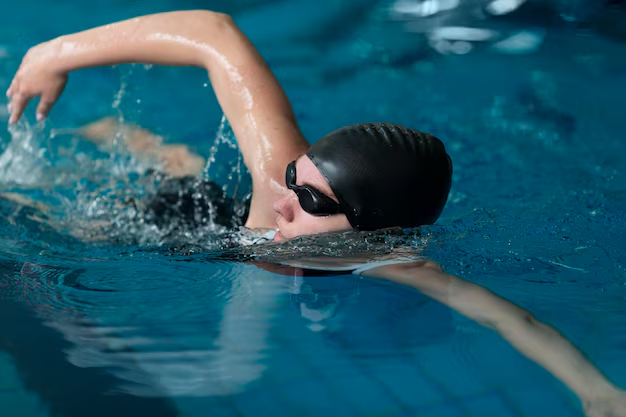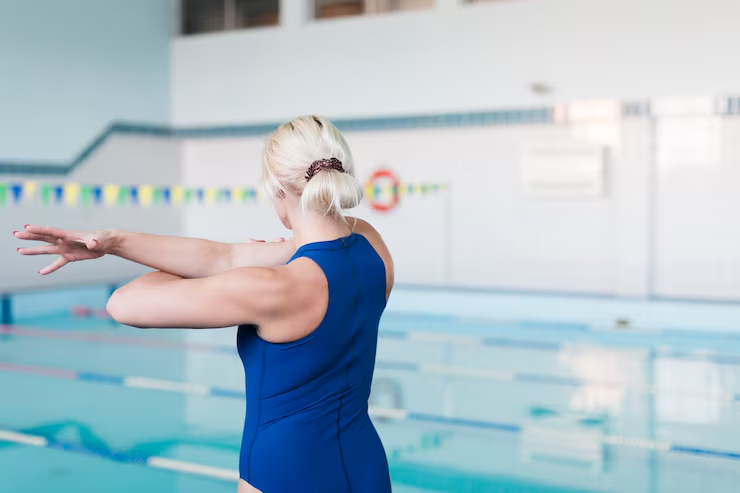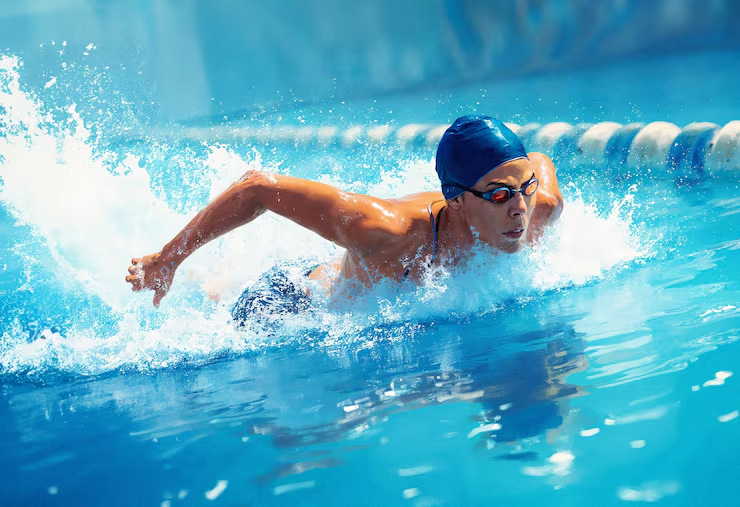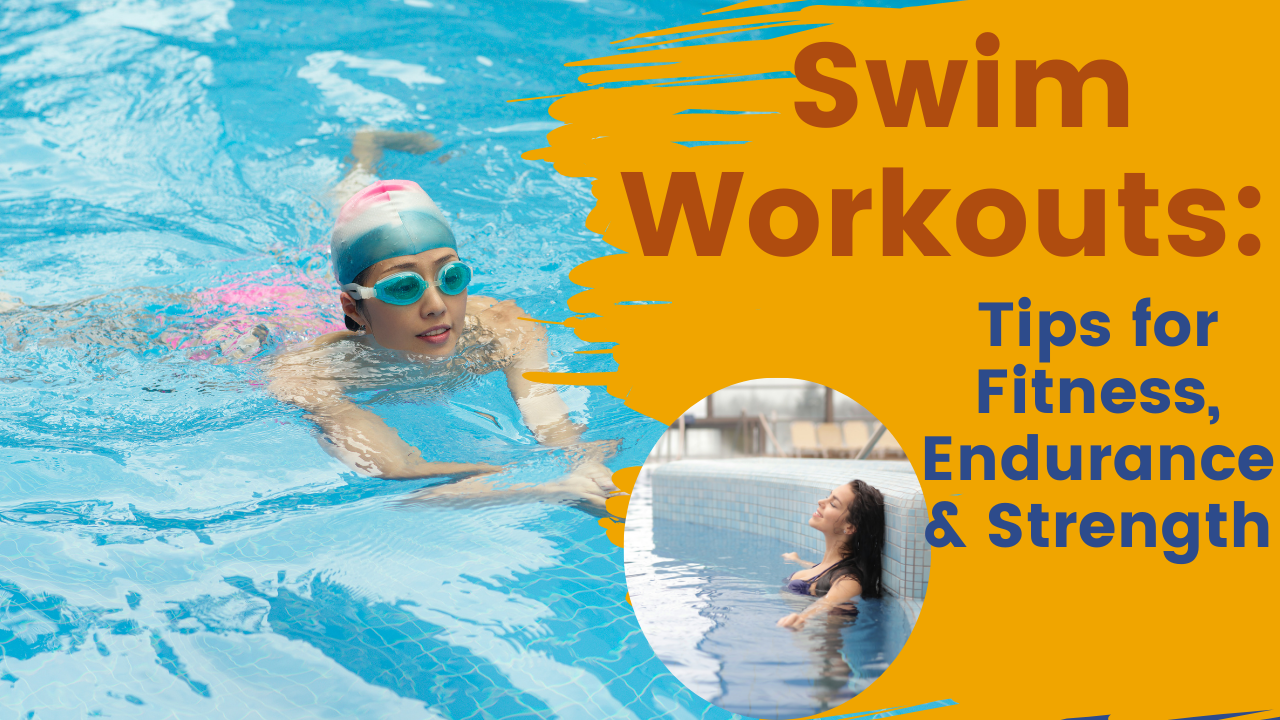Swimming is widely regarded as one of the most complete forms of exercise. Unlike many workouts that focus on isolated muscle groups, swim workouts engage nearly every part of the body, from the core and back to the arms and legs. This full-body engagement helps build lean, strong muscles while improving overall coordination and flexibility.
In addition to strength benefits, swim workouts provide excellent cardiovascular conditioning. The continuous, rhythmic movement in water challenges the heart and lungs, boosting endurance and lung capacity. Swimmers can alternate strokes, intervals, and intensity levels to create a highly effective cardio regimen that is both challenging and low-impact on the joints.
Whether training for a triathlon, aiming to lose weight, or simply looking for a new way to stay fit, swim workouts offer unmatched versatility and efficiency. They combine strength, endurance, and flexibility in one session, making them a powerful tool for total-body fitness and long-term health.

🌊 Why Swim Workouts ?
Before jumping into techniques and tips, let’s understand why swimming is such a powerful workout.
🔹 Full-Body Conditioning: Swimming activates your arms, legs, back, and core with every stroke. No muscle is left untouched, making it one of the few workouts that train strength, endurance, and flexibility all at once.
🔹 Low Impact, High Efficiency: Unlike running or weightlifting, swimming is easy on the joints. The buoyancy of water supports your body weight, reducing stress on your knees, hips, and spine.
🔹 Cardiovascular & Respiratory Benefits: Swimming boosts your aerobic capacity, improves heart health, and increases lung function, especially through breath control exercises.
🔹 Weight Loss & Toning: An hour of swimming can burn 400–700 calories, depending on intensity and body weight. It’s one of the most efficient fat-burning workouts available.
🔹 Mental Wellness: Like meditation in motion, swimming is known to reduce stress, improve mental clarity, and even combat symptoms of depression and anxiety.
How Does Swim Workouts Work ?
Swim workouts work by combining cardiovascular conditioning with full-body muscle engagement. The resistance of water makes each stroke a low-impact strength exercise, engaging the arms, shoulders, back, core, and legs simultaneously. This unique combination helps improve endurance, build lean muscle, and burn calories efficiently without putting stress on joints.
The rhythmic breathing and coordinated movement in swim workouts enhance lung capacity and oxygen utilization. By practicing proper breathing techniques, swimmers maintain energy levels and perform longer sessions, which boosts cardiovascular fitness and overall stamina. Different strokes and intervals can be incorporated to target specific muscle groups and fitness goals, making swim workouts highly versatile.
Additionally, swim workouts promote mental focus and body awareness. The water environment requires concentration on technique and movement patterns, improving coordination and posture. Consistent sessions lead to progressive improvements in strength, endurance, and swimming efficiency over time.
When to Do Swim Workouts
The best time to perform swim workouts depends on your schedule, energy levels, and fitness goals. Many swimmers prefer mornings because it jumpstarts metabolism, improves focus, and sets a healthy tone for the day. Morning swim workouts can also enhance fat-burning when done on a light stomach.
Evening swim workouts are ideal for those who need to relieve stress after a long day. The body tends to be warmer and more flexible later in the day, allowing for better performance and reduced risk of injury. Swimmers may also find they can push intensity higher in evening sessions since meals consumed throughout the day provide additional energy.
Ultimately, the key to effective swim workouts is consistency. Whether you choose mornings, evenings, or split sessions, maintaining a regular schedule ensures progressive improvements in endurance, strength, and technique, while making swim workouts a sustainable part of your fitness routine.
🏁 Types of Swim Workouts
Different goals require different types of swim workouts. Here’s a breakdown of the main categories:
Endurance Swim Workouts
These workouts are designed to improve stamina and aerobic capacity.
Long distance swims (e.g., 1000m+ continuous)
Interval training (e.g., 10 x 100m with 30 sec rest)
Sprint or Speed Workouts
Short and intense sets to build explosive speed and power.
8 x 50m sprints with 1 min rest
Timed 25m or 50m sprints
Technique-Focused Workouts
Perfect your stroke mechanics.
Drills like catch-up, fingertip drag, sculling
Use of kickboards, pull buoys, and paddles
Recovery or Easy Swim Sessions
Low-intensity swims for muscle recovery or active rest.
Easy freestyle laps
Focused breathing and technique
Cross-Training in the Pool
Use swimming as a complement to weight training, running, or cycling.
Swim after a leg day for active recovery
Aqua jogging or resistance band pool training
🏋️♂️ Top Tips for Effective Swim Workouts
Set Clear Goals
Before starting any swimming session, it’s essential to define your goals. Are you aiming to improve speed, build endurance, tone muscles, or focus on recovery? Identifying your objective helps tailor swim workouts to meet your specific needs, ensuring every session is purposeful and effective rather than random or inefficient.
Once your goal is clear, you can structure your swim workouts accordingly. For speed, shorter sprints with rest intervals are ideal, while endurance-focused sessions involve longer distances at a steady pace. Muscle-toning swim workouts emphasize resistance, such as using paddles or fins, whereas recovery sessions focus on gentle, low-intensity strokes to promote circulation and flexibility.
Setting a clear objective also allows you to track progress over time. With consistent, goal-oriented swim workouts, you can measure improvements in performance, endurance, and strength. This strategic approach maximizes the benefits of swimming, helping you achieve both short-term milestones and long-term fitness goals.
Example Goals:
Swim 1000m without stopping
Improve 100m freestyle time
Burn 500 calories in one session
Always Warm Up and Cool Down

Jumping straight into intense swim sessions can lead to muscle cramps, fatigue, and suboptimal performance. Incorporating a warm-up is crucial in swim workouts, as it gradually increases heart rate, loosens tight muscles, and primes the body for rigorous activity. Even a 5–10 minute warm-up of easy laps or dynamic stretches can make a significant difference in both safety and effectiveness.
Equally important is the cooldown phase at the end of swim workouts. Cooling down with gentle swimming or light stretches helps gradually lower heart rate and promotes recovery. It also aids in flushing out lactic acid that builds up during intense exercise, reducing post-swim soreness and stiffness.
Proper warm-ups and cooldowns also improve flexibility and circulation, which are vital for long-term swimming performance. By integrating these phases consistently, swim workouts become safer, more effective, and more sustainable, allowing swimmers to perform at their best while minimizing the risk of injury.
Sample Warm-Up:
200m easy swim
4 x 50m drill work (e.g., kick, pull)
Cool Down:
100m slow stroke
Stretch shoulders, back, and hamstrings
Focus on Technique, Not Just Speed
Swimming is as much about technique as it is about strength. Efficient movement in water reduces drag, conserves energy, and allows swimmers to cover longer distances with less fatigue. Swim workouts that emphasize proper form ensure that each stroke maximizes propulsion while minimizing unnecessary effort, making every session more effective.
Good technique also plays a critical role in injury prevention. Poor form can place undue stress on the shoulders, neck, and lower back, leading to overuse injuries over time. By focusing on swim workouts that incorporate drills for body position, stroke mechanics, and breathing patterns, swimmers protect themselves from strain while enhancing overall performance.
Additionally, mastering proper form makes swim workouts more enjoyable and rewarding. When movements flow smoothly and efficiently, swimmers experience better endurance, speed, and muscle engagement. Over time, consistent attention to technique transforms swim workouts into a safe, sustainable, and highly effective full-body fitness routine
Key Technique Areas:
Body position: Stay streamlined and horizontal
Breathing: Inhale quickly and exhale fully underwater
Kick: Use controlled flutter kicks, not splashes
Mix Up Strokes
Relying solely on freestyle limits the range of muscles you engage during swim workouts. Incorporating a variety of strokes, such as breaststroke, backstroke, and butterfly, ensures balanced development of the upper body, core, and legs. Each stroke targets different muscle groups, enhancing overall strength and coordination while preventing muscular imbalances.
Varying strokes in swim workouts also improves cardiovascular conditioning. Alternating between strokes challenges the heart and lungs in unique ways, promoting better endurance and stamina. Additionally, different strokes emphasize diverse movement patterns, which enhances flexibility, agility, and water efficiency, making your swimming more versatile and effective.
Mixing strokes keeps swim workouts engaging and reduces monotony. It also allows swimmers to focus on specific fitness goals, whether building power, refining technique, or improving speed. By diversifying your strokes, every session becomes a comprehensive workout that strengthens the body, improves technique, and boosts overall swimming capability.
Main Strokes:
Freestyle: Fastest stroke, great for endurance and speed
Backstroke: Targets posterior chain, promotes posture
Breaststroke: Works inner thighs, arms, and chest
Butterfly: Intense stroke, great for core and explosive power
Use Swim Aids & Tools
Incorporate tools to isolate muscle groups or correct technique.
Best Swim Tools:
Kickboard: Focus on legs and flutter kicks
Pull Buoy: Isolates arms and upper body
Paddles: Build strength and increase resistance
Fins: Improve ankle flexibility and speed
Snorkel: Focus on form without worrying about breathing
Track Your Progress
Tracking your progress is a key component of effective swim workouts. Using a swim watch, stopwatch, or phone app allows you to monitor distance, speed, and lap times accurately. This data provides valuable insights into your performance, helping you adjust intensity, pace, and technique to meet your goals.
Logging your swim workouts also encourages consistency. By recording the details of each session—such as duration, strokes, and intervals—you create a tangible record of improvement. Seeing your progress over weeks and months can be highly motivating, reinforcing good habits and highlighting areas that need attention.
Additionally, monitoring metrics during swim workouts enables smarter training decisions. You can gradually increase distance or intensity based on past performance, ensuring progressive overload and continuous improvement. Tracking your workouts helps make each session purposeful, measurable, and efficient, ultimately enhancing endurance, strength, and overall swimming performance.
Track Metrics Like:
Split times
Stroke count
Distance per session
Rest intervals
Don’t Neglect Breath Control

Efficient breathing is a fundamental aspect of effective swim workouts. Many beginners face challenges because they either hold their breath too long or fail to exhale steadily, which can quickly lead to fatigue and reduced performance. Learning to coordinate breathing with stroke patterns allows swimmers to maintain rhythm and conserve energy.
Proper breathing techniques during swim workouts improve oxygen delivery to muscles, enhancing endurance and performance. Exhaling continuously underwater and inhaling quickly when turning the head or surfacing ensures a steady flow of oxygen, preventing early exhaustion. This technique allows for longer, more effective sessions without feeling winded or tense.
Incorporating breathing drills into swim workouts also promotes better stroke efficiency and body alignment. By practicing controlled, rhythmic breathing, swimmers develop a smoother, more fluid motion in the water. Over time, this focus on breathing strengthens stamina, reduces stress, and elevates the overall effectiveness of swim workouts.
Tips:
Practice rhythmic breathing (e.g., breathe every 3 strokes)
Exhale completely underwater
Try hypoxic drills (reduced breathing frequency)
Combine Swimming with Strength Training

While swim workouts are excellent for building cardiovascular endurance and improving overall fitness, adding strength training outside the pool can significantly enhance performance. Dryland exercises, such as push-ups, pull-ups, squats, and core work, strengthen muscles used during swimming, including the shoulders, back, legs, and core. This added strength translates into more powerful strokes, better propulsion, and improved efficiency in the water.
Incorporating 1–2 dryland sessions per week complements swim workouts by addressing muscle imbalances and preventing overuse injuries. Strengthening supporting muscles helps stabilize joints and improves posture, which is crucial for maintaining proper form during long swim sessions. Over time, swimmers notice enhanced speed, endurance, and overall water performance.
Combining swim workouts with targeted dryland strength training creates a holistic approach to swimming fitness. By balancing cardio endurance in the pool with muscular strength on land, athletes can maximize their performance, reduce fatigue, and enjoy safer, more effective training sessions.
Recommended Dryland Moves:
Planks
Pull-ups
Medicine ball slams
Squats and lunges
Resistance band shoulder workouts
📝 Sample Swim Workouts by Goal
🏃♀️ Endurance Builder (Intermediate)
Goal: Improve stamina and pacing
Total Distance: ~2000m
Warm-Up: 200m easy swim + 4 x 50m drills
Main Set: 5 x 200m at moderate pace, 30s rest between
Pull Set: 4 x 100m with pull buoy
Cool Down: 100m easy + stretching
🚀 Sprint Workout (Advanced)
Goal: Build speed and explosive power
Total Distance: ~1500m
Warm-Up: 300m swim + 4 x 50m build speed
Sprint Set: 8 x 50m all-out, 1 min rest
Kick Set: 6 x 25m with fins
Recovery: 100m backstroke
Cool Down: 100m + foam rolling
🌬️ Breath Control & Technique
Goal: Improve breathing and form
Total Distance: ~1200m
Warm-Up: 200m swim + 4 x 25m sculling
Main Set: 6 x 50m breathing every 5 strokes
Drill Set: 4 x 50m catch-up drill
Snorkel Set: 4 x 25m perfect form
Cool Down: 100m
🔄 HIIT Swim Workout
Goal: Burn fat and build VO₂ max
Total Distance: ~1000m
Warm-Up: 200m
HIIT Set: 10 rounds
25m sprint
25m recovery swim
30 sec rest
Cool Down: 200m easy swim
💡 Training Tips for All Levels
Start with 2–3 swim workouts per week
Rest at least 1 day between hard swim sessions
Hydrate! Yes, even in water you sweat
Cross-train with yoga, cycling, or weightlifting
Practice bilateral breathing (both sides)
✅ Benefits of Swim Workouts at a Glance
Benefit Detail
Full-body workout Arms, legs, back, chest, core engaged
Cardiovascular health Increases heart and lung efficiency
Low injury risk Gentle on joints, ideal for recovery
Weight loss Burns 400–700 calories/hour
Mental clarity Reduces stress and improves mood
Versatile Can be adapted for all fitness levels
Conclusion

Swimming is more than just a survival skill or a seasonal hobby; it’s a complete full-body workout that engages nearly every muscle group. Swim workouts challenge the core, arms, legs, and back, providing a balanced routine that improves strength and flexibility simultaneously. Unlike many high-impact exercises, swimming is gentle on the joints, making it ideal for people of all ages and fitness levels.
In addition to strength and flexibility, swim workouts are excellent for cardiovascular health. Regular sessions increase heart and lung efficiency, enhance endurance, and improve overall stamina. By alternating between different strokes like freestyle, breaststroke, and backstroke, you can target different muscle groups and maintain an effective and dynamic cardio routine.
Mental health benefits are another advantage of swim workouts. The rhythmic movement, combined with the calming effect of water, reduces stress, improves mood, and boosts mental clarity. Incorporating regular swim workouts into your routine ensures a holistic approach to physical and mental well-being.
❓FAQs
Q1. How many times a week should I swim for fitness ?
For general fitness, 2–3 sessions per week is ideal. Competitive swimmers may train 5–6 times a week. Consistency is more important than volume.
Q2. How long should a swim workout be ?
A swim session can last anywhere from 30 to 60 minutes, depending on your goals and fitness level. Beginners might start with 20–30 minutes and increase duration gradually.
Q3. Can swimming help with weight loss ?
Yes! Swimming burns a high number of calories and builds lean muscle. Combined with a healthy diet, it’s highly effective for fat loss and body recomposition.
Q4. What stroke is best for a full-body workout ?
While all strokes have benefits, butterfly and freestyle offer the most full-body engagement. Butterfly is more intense, while freestyle is more sustainable.
Q5. Do I need to know all four strokes to benefit from swim workouts ?
No. You can get great results using just freestyle. However, adding strokes like backstroke and breaststroke improves variety, muscle balance, and technique.



